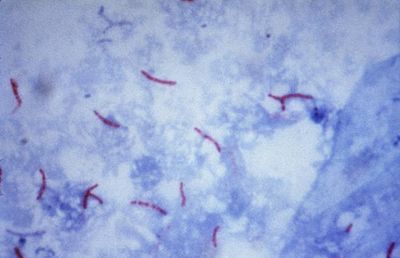Mycobacterium tuberculosis: Difference between revisions
imported>John J. Dennehy |
imported>Alex Lee No edit summary |
||
| Line 69: | Line 69: | ||
Enter summaries of the most recent research here--at least three required | Enter summaries of the most recent research here--at least three required | ||
[http://www.ncbi.nlm.nih.gov/sites/entrez| Pubmed article about BCG vaccine] | |||
==References== | ==References== | ||
[http://www.textbookofbacteriology.net/tuberculosis.html| www.textbookofbacteriology.net] | [http://www.textbookofbacteriology.net/tuberculosis.html| www.textbookofbacteriology.net] | ||
[http://www.ncbi.nlm.nih.gov/sites/entrez Honaker RW, Stewart A, Schittone S, Izzo A, Klein MR, Voskuil MI "BCG vaccine strains lack narK2 and narX induction and exhibit altered phenotypes during dormancy." Infect Immun. 2008 Mar 24] | |||
[http://en.citizendium.org/wiki/Main_Page | Citizendium] | [http://en.citizendium.org/wiki/Main_Page | Citizendium] | ||
Revision as of 01:13, 3 April 2008
Articles that lack this notice, including many Eduzendium ones, welcome your collaboration! |
| Scientific classification | ||||||||||||||
|---|---|---|---|---|---|---|---|---|---|---|---|---|---|---|
| ||||||||||||||
| Binomial name | ||||||||||||||
| Mycobacterium tuberculosis |
Description and significance
Describe the appearance, habitat, etc. of the organism, and why it is important enough to have its genome sequenced. Describe how and where it was isolated. Include a picture or two (with sources) if you can find them.
Genome structure
Describe the size and content of the genome. How many chromosomes? Circular or linear? Other interesting features? What is known about its sequence? Does it have any plasmids? Are they important to the organism's lifestyle?
Cell structure and metabolism
(Temporary General Outline)
- Obligate Aerobe: Explains why it infects the upper lobes of the lungs
- Slow rate of growth compared to other bacteria (about 15-20 hours)
- Non-motile rod shaped
- Size: ~2-4 um in length and 0.2-0.5 um in width
- Acid-fast staining is used (specifically Ziehl-Neelsan Stain)
- Cell wall: peptidoglycan but note 60% lipid (Mycolic Acid, Cord Factor, Wax-D) High lipid percentage results in a lot of interesting properties: (impermeability to stain; different kinds of resistances (antibiotics, osmotic lysis, acidic and alkaline compounds, oxidation).
Ecology
Describe any interactions with other organisms (included eukaryotes), contributions to the environment, effect on environment, etc.
Pathology
(Temporary General Outline)
- Major cause of tuberculosis (can link to tuberculosis page later)
- Binding to mannose receptors (for entry into cell)
- Ability to prevent lysosome from fusing with phagosome, as a result prevents the destruction of the bacteria.
- Slow generation may actually help the bacteria from being detected by the immune system.
- Cell wall construction is 60% lipid. Lot of different types of resistances.
- Antigen 85: binds to fibronectin and may help in protecting the bacteria from the immune system.
- Interference with oxygen intermediates
Application to Biotechnology
Does this organism produce any useful compounds or enzymes? What are they and how are they used?
Current Research
Enter summaries of the most recent research here--at least three required Pubmed article about BCG vaccine
References
www.textbookofbacteriology.net Honaker RW, Stewart A, Schittone S, Izzo A, Klein MR, Voskuil MI "BCG vaccine strains lack narK2 and narX induction and exhibit altered phenotypes during dormancy." Infect Immun. 2008 Mar 24 | Citizendium
